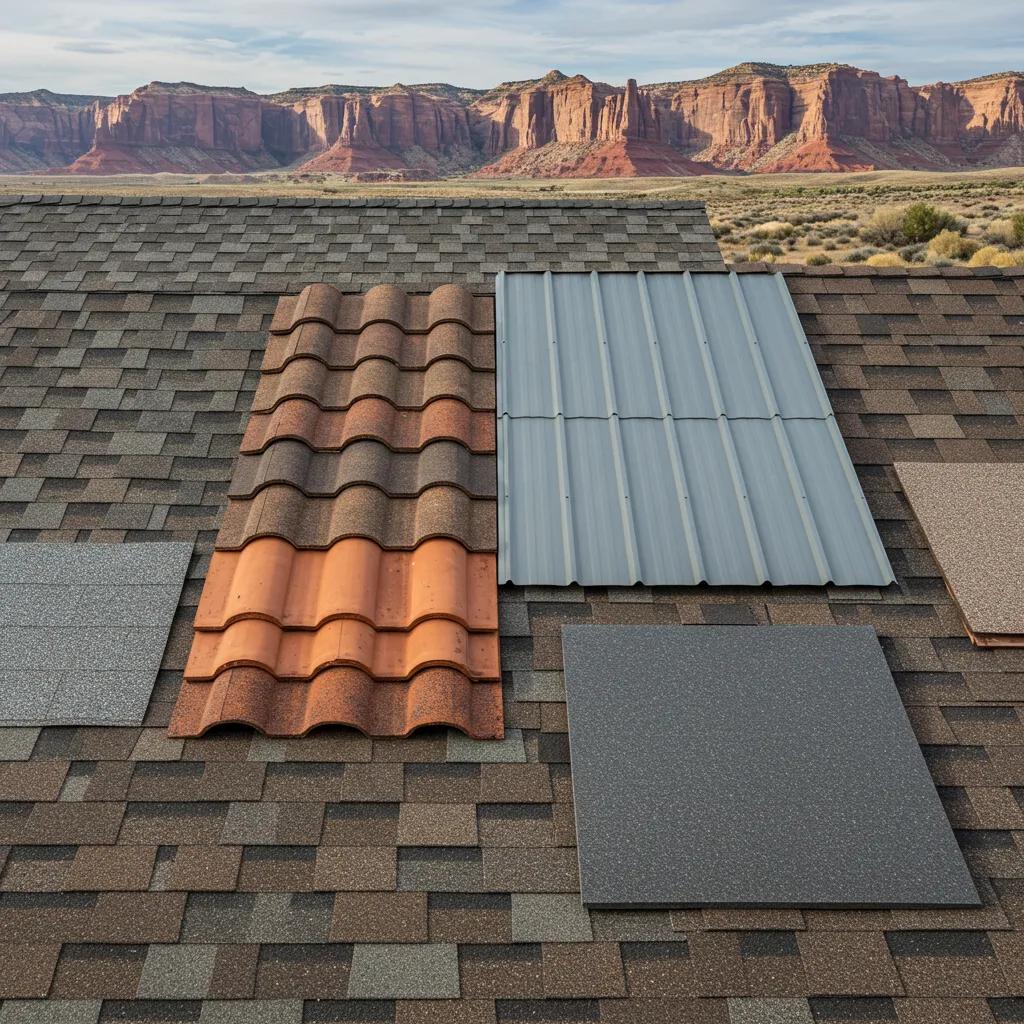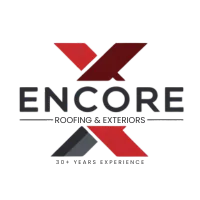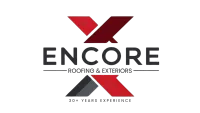Encore Roofing Blog
Tips, Trends & Insights for Utah Homeowners & Businesses
Stay informed with expert insights on roof replacements, commercial flat roofing systems, seamless gutters, siding, and decking in Utah. Our blog is designed to help homeowners and business owners protect their property, extend roof life, and make smart investment decisions.

Roofing Tips.
Trends.
Insights.
Top Roofing Materials for Utah: A Homeowner's Guide
Utah Homes: Choosing the Right Roofing Materials for Our Unique Climate

As a Utah homeowner, you know our weather is something else—from heavy snow and fierce hailstorms to scorching summer sun. Picking the right residential roofing materials here in Utah can be the difference between constant repairs and decades of peace of mind. This guide breaks down durability, energy efficiency, costs, installation needs, and upkeep for the most popular options: asphalt shingles, metal panels, clay and concrete tiles, and TPO for those lower-slope commercial roofs. You’ll discover how Utah’s climate impacts material performance, compare initial and long-term expenses, explore greener choices, and get a handle on installation and care. We’ll even help you match materials to different home styles, budgets, and the unique micro-climates found from our valleys to our mountain slopes. Plus, see how Encore Roofing & Exteriors goes beyond this expert advice with free roof inspections and personalized estimates to help you make confident roofing decisions.
What Roofing Materials Stand Up Best to Utah’s Extreme Weather?

When we talk about durability in Utah, we mean standing up to heavy snow, hail impacts, intense UV rays, and strong winds. Materials that boast a proven lifespan and Class 4 impact ratings are your best bet for long-term performance in these conditions. Here’s a look at the main contenders, their key durability features, and how they tackle Utah’s specific weather challenges.
| Material | Key Durability Feature | Benefit for Utah’s Climate |
|---|---|---|
| Asphalt Shingles | Class 4 Impact Resistance | Protects against hail damage and wind-blown debris |
| Metal Roofing | Corrosion-Resistant Alloy | Prevents rust and leaks from snow and moisture |
| Clay/Concrete Tile | Exceptional Compressive Strength | Withstands heavy snow loads without cracking |
| TPO Membrane | UV-Stabilized Surface | Reflects solar heat and resists degradation from sun exposure |
Each material’s durability profile is tailored to specific weather threats common in Utah. With this understanding, you can better assess how individual materials will perform under snow, hail, and fluctuating temperatures.
How Do Asphalt Shingles Handle Utah’s Snow and Hail?
Asphalt shingles offer impressive durability, thanks to their fiberglass reinforcement and asphalt coatings that achieve Class 4 impact ratings. They effectively shed snow and resist punctures from hail up to an inch in diameter. Unlike older styles, modern architectural shingles interlock for better wind resistance and reduced granule loss from UV exposure. Homeowners appreciate their straightforward installation, moderate cost, and widespread availability. Encore Roofing & Exteriors installs impact-resistant asphalt shingles that meet or exceed industry standards, ensuring your home is protected through Utah’s snowiest winters and hail-prone seasons.
Asphalt Shingle Wind Resistance: The Impact of Unsealing and Adhesion
The influence of unsealing on the wind resistance of asphalt shingles is a critical factor in roofing performance, particularly in regions susceptible to high winds. Asphalt shingles are the most prevalent roofing material in many areas, and their capacity to resist wind uplift is directly correlated with the integrity of their sealant strips.
What Are the Advantages of Metal Roofing in Utah’s Climate?
Metal roofing provides an exceptionally long lifespan, often exceeding 50 years, thanks to its corrosion-resistant coatings on steel or aluminum panels. Its smooth surface allows snow to slide off easily, preventing buildup that can strain your roof deck. Reflective finishes offer significant energy savings by keeping attic temperatures down during intense summer sun, and concealed fasteners minimize potential leak points during heavy rain or hail. Metal panels interlock to deliver superior wind resistance, with some systems earning Class 4 hail impact ratings. Investing in metal roofing means investing in both durability and energy efficiency for your Utah home. Encore Roofing & Exteriors provides complete installation services, backed by manufacturer warranties.
How Tough Are Tile Roofing Options for Utah Homes?
Tile roofs, crafted from natural clay or robust concrete, combine impressive compressive strength with low water absorption, making them perfect for areas experiencing freeze-thaw cycles. Their substantial weight helps resist wind uplift and absorb the impact of hailstones, while protective glazes offer UV stability, preventing color fading. Although tile roofs require a reinforced roof deck and a higher initial investment, their expected lifespans often surpass 75 years with minimal upkeep. In mountainous communities, the weight and longevity of tile complement rustic architectural styles, offering both beauty and resilience against Utah’s unpredictable climate.
Frost Durability of Clay Roofing Tiles: Microstructural and Freezing Test Analysis
Water absorption is a critical factor influencing the durability of fired-clay materials exposed to freeze-thaw cycles, posing a significant concern for the longevity of clay roofing tiles. The impact of microstructural and compositional parameters on the frost resistance of roofing tiles was evaluated using a dual methodology: conducting rigorous freeze-thaw testing and detailed microstructural analysis.
Are Flat Roofing Materials Like TPO a Good Fit for Utah Commercial Properties?
Absolutely. TPO membranes offer a durable, low-slope roofing solution ideal for commercial buildings and multi-family structures throughout Utah. Their UV-stabilized surfaces reflect heat, helping to reduce cooling costs, while expertly welded seams ensure watertight performance through rain, snow, and frost. TPO also resists chemical exposure, ozone degradation, and hail impacts, often achieving Class 4 ratings when specified correctly. Installing TPO over insulation board boosts R-values, enhancing energy efficiency across large roof areas. For property managers seeking a cost-effective, long-lasting flat roofing system, Encore Roofing & Exteriors designs and installs TPO solutions specifically suited to Utah’s building codes and climate demands.
Impact of Regional Weather Conditions on the Performance of Single-Ply Roofing Membranes: TPO, PVC, and EPDM
Regional weather variations across the country can significantly influence the performance of roofing membranes, affecting the long-term stability and functionality of single-ply roofing systems, including Thermoplastic Polyolefin (TPO), Polyvinyl Chloride (PVC), and Ethylene Propylene Diene Monomer (EPDM). Various weathering factors, such as humidity, salinity, UV exposure, and freeze-thaw cycles, were simulated under laboratory conditions to replicate diverse climatic conditions prevalent in different regions of the United States. These laboratory simulations allow for the correlation of aging effects with specific regions based on their distinct weathering patterns. Consequently, this enables more accurate predictions of roofing performance, which can inform the selection of appropriate roofing systems and warranty strategies.
How Does Utah’s Climate Shape Your Roofing Material Choices?
Utah’s climate is a unique blend of heavy winter snowfall, dramatic temperature swings, and intense summer sunshine. Snow loads can easily surpass 30 pounds per square foot, and summer highs in the valleys frequently climb above 95°F. These conditions are crucial factors in selecting roofing materials, testing their impact resistance, tolerance for thermal expansion, and UV stability.
What Effect Do Snow Loads and Temperature Swings Have on Roofs?
Accumulating snow puts a static weight on your roof that can warp or even collapse inadequately supported structures, making compressive strength and proper slope critical. Freeze-thaw cycles can worsen existing cracks in brittle materials, so resistance to moisture absorption is key. Metal and tile roofs excel under heavy snow because they shed it quickly. Asphalt shingles require appropriate underlayment and ventilation to prevent ice dams and shingle lift during rapid temperature changes.
How Does UV Radiation Impact the Lifespan of Roofing Materials?
Ultraviolet radiation can degrade the organic compounds in asphalt and accelerate chalking or fading in painted metal finishes. High-performance coatings and heat-reflective granules help combat UV damage by absorbing or bouncing away harmful rays. TPO membranes are manufactured with UV stabilizers integrated into their polymer structure, extending their service life. Clay and concrete tiles naturally resist UV erosion, maintaining their color and structural integrity even under prolonged sun exposure.
What Are the Risks of Hail and Wind Damage to Utah Roofs?
Hailstorms in Utah can unleash stones larger than an inch in diameter, capable of damaging unreinforced shingles and denting metal panels. Wind gusts exceeding 60 mph can lift unsecured roofing components, tearing away edge flashings or ridge caps. Materials rated for Class 4 impact resistance or tested to UL 2218 standards offer the highest level of protection against hail. Using proper fastening patterns, high-wind-rated underlayments, and effective sealing methods significantly reduces the likelihood of wind-related failures.
What Are the Cost Factors for Roofing Materials in Utah?
The cost of materials and labor can vary significantly across different roofing options. Homeowners should consider the initial investment, expected lifespan, ongoing maintenance expenses, and potential energy savings when budgeting for a new roof.
How Do Material and Installation Costs Compare for Common Roof Types?
Expect initial costs per square foot to typically fall within these ranges:
- Asphalt Shingles: $3–$5 installed
- TPO Membrane: $5–$7 installed
- Metal Panels: $7–$12 installed
- Tile Roofing: $10–$20 installed
While metal or tile roofs require a higher upfront investment, they often provide longer lifespans and lower maintenance needs, balancing out the total lifecycle costs compared to replacing cheaper shingles multiple times over the decades.
What Other Expenses Should Utah Homeowners Budget For?
Beyond the materials and installation labor, you should anticipate costs for permit fees, potential deck reinforcement for heavy tile or metal roofs, underlayment and ventilation upgrades, disposal of your old roofing, and any structural repairs that might be discovered during removal. For snowy regions, adding ice-dam and snow-guard systems will increase the budget. Ongoing maintenance costs include professional roof inspections and gutter upkeep.
Are There Financing Options for Roof Replacements in Utah?
Encore Roofing & Exteriors partners with local lenders to provide flexible financing solutions that allow you to spread the expense over time. Options like home equity lines of credit, personal loans, and manufacturer financing programs offer various terms for your new roof investment. If storm damage from hail or wind has caused verified harm to your existing roof, insurance claims may also cover a portion of the replacement costs.
How Do Energy Efficiency and Sustainability Play a Role in Roofing Choices in Utah?

Energy-efficient roofs not only help lower your cooling bills but also contribute to reducing urban heat islands. Sustainable materials, meanwhile, support environmental goals and may even qualify you for rebates or tax credits.
Which Roofing Materials Offer the Best Insulation and Solar Reflectivity?
Metal roofing with reflective coatings can achieve Solar Reflectance Index (SRI) values exceeding 70, potentially reducing attic heat gain by up to 30 percent. TPO membranes often score above 0.60 for reflectivity percentages, meeting ENERGY STAR requirements. Using high-performance underlayments and installing ridge vent systems can further enhance your roof’s R-value by maintaining consistent insulation performance.
What Are the Energy Savings Benefits of Metal Roofing in Utah?
Metal panels dissipate heat quickly as dusk approaches, preventing heat from lingering in your attic overnight. Reflective paints help lower peak temperatures and decrease the demand on your air conditioning system. Over a 20-year period, the energy savings generated can help offset a portion of the higher installation costs, providing both increased comfort and reduced utility bills during Utah’s hot summers.
Are Sustainable Roofing Options Available for Utah Homeowners?
You can find shingles and tiles made with recycled content, or tiles composed of clay or concrete incorporating reclaimed aggregates, all of which reduce the demand for new raw materials. Cool-roof coatings and green-roof systems featuring vegetative layers can improve stormwater management and insulation. These choices align with state incentives for energy-efficient home upgrades and demonstrate a commitment to environmental responsibility.
What’s the Typical Installation and Maintenance Process for Utah Roofing Materials?
A well-managed replacement or repair process ensures quality, compliance with regulations, and minimal disruption to your daily life.
What Should Homeowners Expect During a Roof Replacement or Repair?
A professional replacement project typically starts with an inspection, followed by the removal of old materials, any necessary deck repairs, installation of underlayment and flashing, then the application of the new roofing materials, and finally, a thorough cleanup. The entire process usually takes between two to five days, depending on the complexity of the roof and the weather conditions. Encore Roofing & Exteriors provides daily progress updates to keep you informed and ensure the worksite remains safe.
How Can Utah Homeowners Keep Their Roofs in Top Shape for Years to Come?
Regular maintenance involves clearing debris from roof valleys and gutters, inspecting for any loose or damaged shingles or panels after storms, and scheduling professional inspections every three to five years. Addressing failing components promptly and resealing any roof penetrations can prevent leaks and costly structural damage.
What Local Building Codes and Regulations Apply to Roofing in Utah?
Local jurisdictions have specific requirements for wind- and snow-load ratings, fire-resistance classifications, and underlayment types. Installing tile and metal roofs often necessitates engineering plans and official stamped approvals. Encore Roofing & Exteriors handles the permit processes and ensures code compliance on your behalf, delivering complete roofing systems that meet all regulations.
How Can Utah Homeowners Select the Best Roofing Material for Their Specific Needs?
Choosing the right roof involves balancing your performance priorities, aesthetic preferences, and budget constraints with the unique attributes of each material.
Which Roofing Materials Best Suit Different Home Styles and Budgets?
Asphalt shingles are a great fit for traditional, Craftsman, and cottage-style homes with moderate budgets. Metal panels complement modern, farmhouse, and mountain lodge designs, offering mid-range to premium pricing. Clay or concrete tiles are ideal for Mediterranean, Spanish, and high-end luxury properties where a larger investment is planned. TPO membranes are best suited for commercial structures and flat roof applications across all budget levels.
How Do Micro-Climates Within Utah Influence Roofing Choices?
Higher elevation communities often experience heavier snowfall and more intense UV radiation, making tile or metal roofing with steep slopes a strong choice. Valley areas, with their extreme summer heat, benefit greatly from reflective metal or TPO membranes. Transitional foothill neighborhoods might require a balanced approach—perhaps impact-resistant shingles combined with enhanced ventilation and insulation systems.
When Should You Consider Replacing or Repairing Your Roof in Utah?
Key signs of an aging roof include curling or missing shingles, granules accumulating in your gutters, visible rust or corrosion on metal components, cracked tiles, and interior water stains. After 20–25 years, asphalt shingles often reach the end of their service life, while metal and tile roofs can last well over 50 years before needing replacement. Scheduling an inspection at the first sign of wear is crucial for preserving the underlying structure and preventing expensive water damage.
Where Can Utah Homeowners Find Reliable Roofing Contractors and Services?
Partnering with a trusted local expert ensures high-quality workmanship, appropriate material selection, and responsive service throughout your roof’s lifespan.
Why Should You Choose Encore Roofing & Exteriors for Your Utah Roof Replacement?
Encore Roofing & Exteriors specializes in residential and commercial roof replacements across Utah. We combine in-depth knowledge of local climate challenges with manufacturer-backed product warranties. Our team adheres to industry best practices, uses high-performance materials, and provides transparent pricing. We offer free roof inspections and estimates, empowering homeowners to make informed decisions without any pressure.
How Can You Request a Free Roof Inspection or Estimate in Utah?
Homeowners can easily contact Encore Roofing & Exteriors to schedule a complimentary on-site evaluation. A certified technician will assess your roof’s condition, discuss material options, and provide a detailed, no-obligation estimate tailored to your specific needs and budget. This straightforward process simplifies planning and ensures the project scope aligns perfectly with your expectations.
What Do Utah Customers Say About Their Roofing Experiences?
Our clients consistently commend our timely communication, professional installation, and the long-lasting performance of their new roofing systems. Many express relief and peace of mind thanks to our thorough inspections and helpful maintenance guidance. This positive feedback highlights Encore Roofing & Exteriors’ strong reputation for quality, reliability, and local expertise in meeting Utah’s demanding roofing needs.
In Utah’s diverse climate, selecting the right roofing material is fundamental to ensuring long-term protection and energy efficiency for your home. By comparing the durability, cost, installation, and maintenance characteristics of asphalt shingles, metal, tile, and TPO, homeowners can effectively align their performance priorities with their budget and style preferences. Understanding how snow loads, UV exposure, hail, and wind impact material behavior leads to smarter choices. Exploring financing options, sustainability incentives, and professional guidance further simplifies the decision-making process. When you’re ready to move forward, Encore Roofing & Exteriors offers free inspections and customized estimates to guarantee your Utah home benefits from an optimized roofing solution built specifically for our local conditions. Contact Encore Roofing & Exteriors today to secure a dependable, weather-resistant roof that will protect your investment for decades to come.

